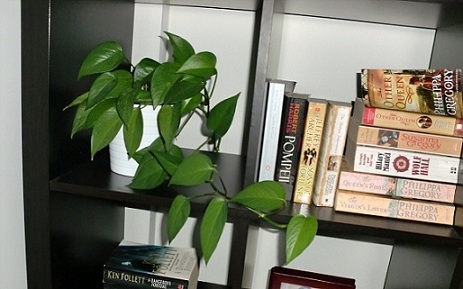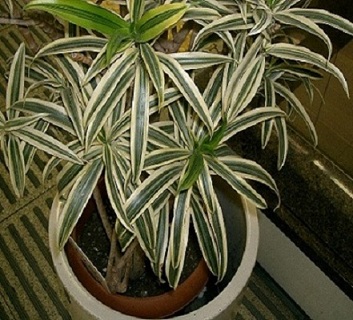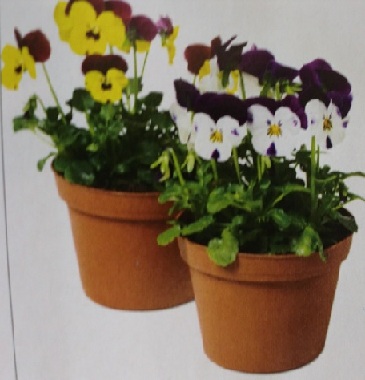Plants enhance the interiors
One can strive to do something different to one's home and interior by bringing in some of the lovely things that nature has to offer like rocks, plants, even wild plants, an interesting looking bark or drift wood, pebbles and arrange them together. Nature as we know has timeless beauty that never goes out of fashion, besides it has the power of revitalizing us. Adding lots of plants and foliage are a must for bringing our interiors to life. A bunch of wild summer flowers and some attractive leaves bunched together add a pretty splash of color to any room, you don’t have to bring expensive flowers from a florist to beautify your sitting room or dining hall. Incorporate natural designs such as decorative leaves and twigs along with some pebbles and rocks and one can have a rock garden in the corner of one’s sitting room or at the entrance or in the balcony which becomes the most attractive and loved space in your house.
These days no interior is complete without having some greenery in it. Almost all interior designers stress on the importance of having plants, flowers or foliage to not only enhance the look of our sitting room, but also the importance of bringing nature into our home.
With the rising population, limited space and increasing land prices, the concept of flats and apartments has caught on even in smaller cities. No doubt that they provide us with a roof over our heads , but the main problem with the apartments is that you are devoid of any greenery or an opportunity to have a garden of your own like it can be done in a house or a bungalow. So, the next best thing to do is to bring the garden indoors! With some planning you can have a little garden of your own in your balcony or spread out in your living room, kitchen window or even the little space you have in front of the apartment.
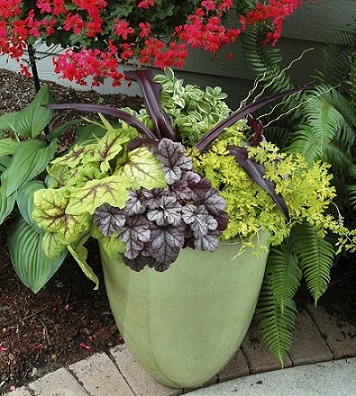
For someone new to the concept of indoor gardening, it may take a while to get it going since it is not as easy to grow plants indoors as it is to grow outside and some care and special attention is needed. However, once you master the art of indoor gardening it can yield year-round plants if the gardener provided you are equipped with the right tools and have some information. Once you are ready to start a indoor garden of your own, you will find that it is a very pleasurable hobby that keeps you occupied in a very healthy manner.
The greatest advantage is that unlike outdoor gardening which normally lasts through the spring and summer and may be winter if it is mild, indoor gardening can be done all through the year. One can grow plants all year without worry of temperature changes or harsh weather conditions. Indoor gardening also has the advantage of requiring much less time and financial commitment besides allowing a beginner to easily learn the hobby. One can start with just one pot kept on a kitchen window growing herbs like mint or coriander.
Some basic points to be kept in mind
Some points should be kept in mind when you plan to have an indoor garden since it is imperative that you know what it involves before starting one!
1. Light - Just like plants grown outdoors, even indoor gardens require a light source. The source can be artificial or a sunny location like a balcony or a sun roof jutting or a side wall close to a window. If you don’t have a proper spot within your home where the plants get sufficient light, keep the plants outside for a few hours or if possible for at least a week. This can be done if you have another set of plants that can be bought inside.
2. Soil -It is important to use a good quality, nutrient-rich potting soil in your container for growing plants. A good idea is to grow saplings in sand where the rooting process is faster after which you can add on the potting soil which is mixed with compost.
3. Containers -Plants will need a container that allows room for growth, so they need to be re-potted from time to time to a larger pot when you see that roots are visible from the top or begin to overlap. Overlapping roots hinder a plant's growth and also a sign that the plant needs fresh soil.
4. Watering-One of the major problems that indoor plants face is over watering, which eventually leads to root rot and the plant dies. It is important that you water plants only on demand when the soil is no longer moist on top which may be once in 3 or 4 days. Water sparingly just to get the soil moist. If possible it is advisable to use distilled water for plants. Very cold tap water can shock plants that are not as hardy.
5. Temperature - Most gardeners are of the opinion that maintaining the room temperature between of 65 to 75 degrees Fahrenheit, with the temperature decreasing by 10 to 15 degrees at night, would be ideal for plants. Depending on the changing weather conditions one has to provide the right setting for plants.
6. Containers -Since plants are grown in containers it is important to keep certain basic facts in mind , The container that you select should have proper drainage holes on the side and at the bottom. In case you find a container that you like but has no drainage holes you can make a couple of holes yourself .If it is plastic, hold a iron rod to the flame and press it down to the bottom side of the container and you will get a perfect round hole. Have at least two holes, one preferably at the side. This is to make sure that there will be no problem with the drainage.
7. Plants -Select plants that need medium to low light and also remember that majority of the plants have a tendency to get inclined towards a light source. We see this happening even outdoors when plants grow towards light when they are kept in the shade. To make sure that our indoor plants grow straight and all round, it is necessary to rotate them on an occasional basis by turning each side to the source of light.
8. Cleaning -We can see that over a period of time, dirt, dust and grime tend to settle on the leaves as well as on the stem of the plants thereby making them look dull and lifeless. So, they need to be wiped and cleaned every now and then with a folded towel and if possible spray the plants using a small hose pipe. You can place the plants either in your bathroom or in the balcony while doing this. However, make sure that you are gentle while giving a shower to the plants.
9. Fresh air - Fresh air is very essential, plants are very sensitive to atmosphere especially when they are grown indoors. Just like sunlight and water, they also need lots of fresh air to grow well and remain healthy. Make sure that you keep them away from smoky or stagnant air. Keep the windows wide open during the day time and place the plants near a window that receives proper ventilation.
10. Liquid Fertilizers should be added to the indoor plants on a regular basis. The soil loses essential nutrients every time we water the plants and they need to be replenished.. So, according to most gardening experts it is advisable to use a liquid fertilizer in small quantities , mixed with the water.
11. Pests and insects -Most potting soil contains enough nutrients to feed a plant for 4 or 5 months. However use natural fertilizers or a compost made at home every six months. Also check thoroughly for insects such as aphids and spider mites which can completely destroy your plant. These insects can cause problems if they spread to other indoor plants as well. It is safer to use natural pesticides such as a mild soap solution, left over alcohol ( flat beer ) and a couple of green chilies crushed in water and added to the plants.
Different Types of Indoor plants
House plants provide us an excellent opportunity to have the much needed greenery around us and make the interiors warm and welcoming . There are several varieties of house plants that are available in the plant nurseries and garden centers that are suitable for growing indoors. The most common of them being tropical plants. House plants are also being extensively used these days to adorn office spaces. They form a vital and very important part of landscaping, giving that extra energy to the space with their beautiful foliage and colorful blooms.
Apart from being making the place look much more decorative, house plants also serve a more important purpose by being the best air purifiers. One should remember that not all house plants would adapt to the interiors and certain factors should be kept in mind while choosing house plants.
I am giving here a list of some popular tropical plants that one can opt from and can be easily grown indoors
Begonia
Begonia is one of the most popular house plant since it grows much better in shade. It is available in many attractive shades of white, pink, red and yellow, brown ,green ... It can be grown all year round in hanging pots or in planters both indoors and outdoors. Begonia normally requires warm climate and shade hence, should be kept away from direct sunlight . With the right conditions they spread very fast and look absolutely delightful with their colorful foliage and patterns. It should be re-potted every year. While doing that you can divide the plant into 2 or 3 sections and plant them in different pots so that you have many more plants that can be either grouped together or placed separately. Proper fertilization is a must since the plant is active and growing all the time.
Peace Lily
Peace lilies or white sails as sometimes they are called are one of most the favorite plants because it is easy to grow and maintain. The large dark leaves and beautiful white flowers add on to the look and decor of any house. They don’t require much sunlight and can grow well in shaded areas. All that is needed is adequate water and they need to be provided a certain level of humidity. Because Peace lilies require very little maintenance, they are the best out of all the indoor plants. They are also known to be excellent air purifiers which is an added advantage.
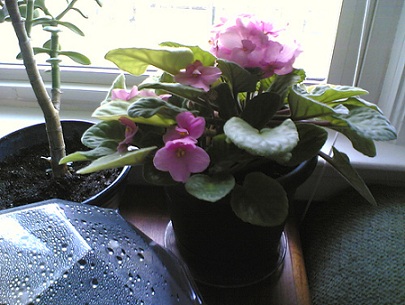
African Violets
African violets with velvety flowers and beautifully patterned leaves are famous as house plants for their long lasting blooms. African plants are perennial plants that grow well in very low light or even artificial light. In fact the plants should not be exposed to direct sunlight since the direct rays can lead to the decaying and drying of the leaves. There are many fertilizers available in garden centers that are specifically meant for African violets. Cacti Almost all varieties of Cacti make the best house plants. These require little or almost no maintenance and can be kept on the windowsill for weeks together without water. They are even not bothered by insects or pests because of the thorns ; therefore there is no need for any pest control measures.And of course they look very decorative inside the house.
Ivy, Goose-foot plant and Money plant (Scindapsus aureus)
All three can grow in any given condition and require very little care, making them the best indoor house plants ever known. All of these plants can thrive in low or medium light and can be grown in hanging pots to allow its shoots to hang down. In fact they look their best when they are growing out of baskets and hanging down. We have to keep them away from direct sunlight and also make sure not to over-water the plants. Use fertilizers sparingly since they grow properly with just light and water and perform their function as an air purifier as well.
To conclude, along with the pleasure of starting an indoor garden, one should also be prepared to face some problems, but none that cannot be overcome and benefits of growing houseplants actually far outweigh any disadvantages. Once you identify the problems that can arise and how to avoid or deal with them, you can grow a garden that you can be proud of. The five common problems that needs to be looked into are lack of enough light, attack from pests, humidity, overwatering and use of fertilizers. Once these are regulated one can be sure that the plants would thrive and make you feel good all round.
